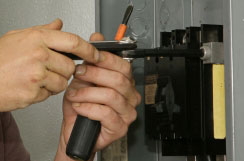 |
 |
Commercial HVAC Portsmouth, VA
Replacing Your Furnace or Boiler
Although older furnace and boiler systems had efficiencies in the
range of 56%–70%, modern conventional heating systems can achieve
efficiencies as high as 97%, converting nearly all the fuel to useful
heat for your home. Energy efficiency upgrades and a new high-efficiency
heating system can often cut your fuel bills and your furnace's pollution
output in half. Upgrading your furnace or boiler from 56% to 90%
efficiency in an average cold-climate house will save 1.5 tons of
carbon dioxide emissions each year if you heat with gas, or 2.5 tons
if you heat with oil.
If your furnace or boiler is old, worn out, inefficient, or significantly
oversized, the simplest solution is to replace it with a modern high-efficiency
model. Old coal burners that were switched over to oil or gas are
prime candidates for replacement, as well as gas furnaces with pilot
lights rather than electronic ignitions. Newer systems may be more
efficient but are still likely to be oversized, and can often be
modified to lower their operating capacity.
Before buying a new furnace or boiler or modifying your existing
unit, first make every effort to improve the energy efficiency of
your home, then have a heating contractor size your furnace. Energy-efficiency
improvements will save money on a new furnace, because you will need
a smaller furnace. A properly sized furnace will also operate most
efficiently. You'll also want to look for a dependable unit and compare
the warranties of each furnace or boiler under consideration.
When shopping for high-efficiency furnaces and boilers, look for
the ENERGY STAR label. If you live in a cold climate, it usually
makes sense to invest in the highest-efficiency system. In milder
climates with lower annual heating costs, the extra investment required
to go from 80% to 90%-95% efficiency may be hard to justify.
You can estimate the annual savings from heating system replacements
by using Table 1. The table assumes that both furnaces have the same
heat output. However, most older systems are oversized, and will
be particularly oversized if you significantly improve the energy
efficiency of your home. Because of this additional benefit, your
actual savings in upgrading to a new system could be much higher
than indicated in the table.
Specify a sealed combustion furnace or boiler, which will bring outside
air directly into the burner and exhaust flue gases (combustion products)
directly to the outside, without the need for a draft hood or damper.
Furnaces and boilers that are not sealed-combustion units draw heated
air into the unit for combustion and then send that air up the chimney,
wasting the energy that was used to heat the air. Sealed-combustion
units avoid that problem and also pose no risk of introducing dangerous
combustion gases into your house. In furnaces that are not sealed-combustion
units, back drafting of combustion gases can be a big problem.
High-efficiency sealed-combustion units generally produce an acidic
exhaust gas that is not suitable for old, unlined chimneys, so the
exhaust gas should either be vented through a new duct or the chimney
should be lined to accommodate the acidic gas.
Maintaining Furnaces and Boilers
The following maintenance should be provided by a heating system
professional.
All systems:
•
Check the condition of your vent connection pipe and chimney. Parts
of the venting system may have deteriorated over time. Chimney problems
can be expensive to repair, and may help justify installing new heating
equipment that won't use the existing chimney.
•
Check the physical integrity of the heat exchanger. Leaky boiler
heat exchangers leak water and are easy to spot. Furnace heat exchangers
mix combustion gases with house air when they leak—an important
safety reason to have them inspected.
•
Adjust the controls on the boiler or furnace to provide optimum water
and air temperature settings for both efficiency and comfort.
•
If you're considering replacing or retrofitting your existing heating
system, have the technician perform a combustion-efficiency test.
Forced-air Systems:
•
Check the combustion chamber for cracks
•
Test for carbon monoxide (CO) and remedy if found
•
Adjust blower control and supply-air temperature
•
Clean and oil the blower
•
Remove dirt, soot, or corrosion from the furnace or boiler
•
Check fuel input and flame characteristics, and adjust if necessary
•
Seal connections between the furnace and main ducts.
Hot-water Systems:
•
Test pressure-relief valve
•
Test high-limit control
•
Inspect pressure tank, which should be filled with air, to verify
that it's not filled with water
•
Clean the heat exchanger.
Steam Systems:
•
Drain some water from the boiler to remove sediments. This improves
the heat exchange efficiency
•
Test low-water cutoff safety control and high-limit safety control
•
Drain the float chamber to remove sediments. This prevents the low-water
cutoff control from sediment clogs
•
Analyze boiler water and add chemicals as needed to control deposits
and corrosion
•
Clean the heat exchanger
Also see: Furnaces and Boilers.
Click here for a free
confidential quotation
Or give us a call today at (757) 333-3114.
|
| |
 Commercial
& Residential HVAC Commercial
& Residential HVAC
Commercial & Residential Service Provider
in Portsmouth, VA
|
|
|

